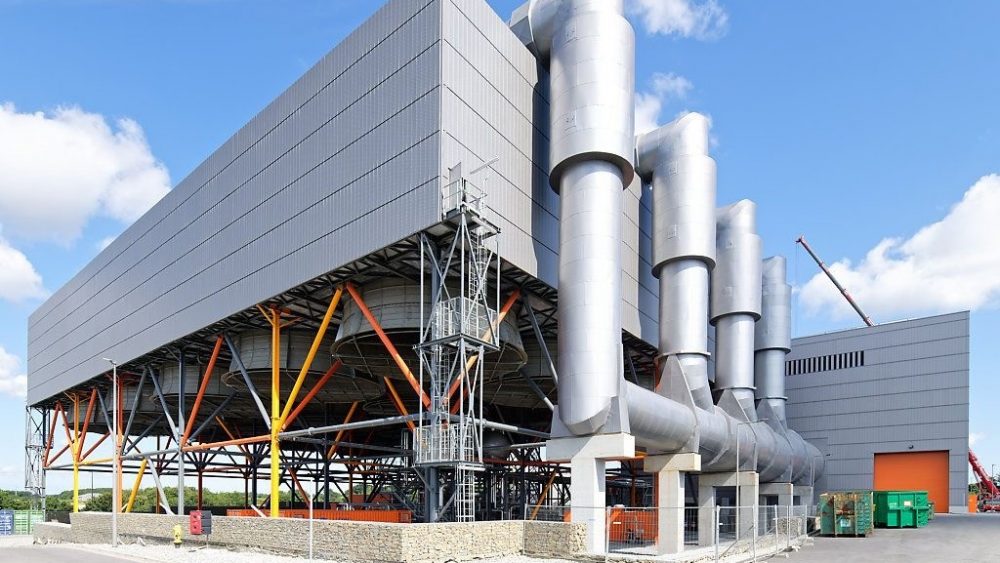Efficient Approach Dramatically Reduces Turbine Noise at CCGT Power Stations
Ten years after it was first used at Uskmouth, this innovative approach to soundproofing that reduces insulation depth by up to 76%, is once again commissioned in France.
Dangerous Levels of Noise
Modern dry cooling systems offer many benefits over traditional systems in CCGT power stations, but they have the disadvantage of being a complex source of noise transmission. The turbine noise recorded coming from the dry cooling system at the Severn Power CCGT Power Station at Uskmouth was between 130dB(A) and 135dB(A). Exposure to these levels of noise, a full 50dB above The Control of Noise at Work Regulations 2005 “upper action level”, will cause both immediate and permanent damage.
When acoustics and soundproofing specialist, CMS Danskin Acoustics, were brought in by SPX Cooling Technologies, designers of Uskmouth’s dry cooling system, they discovered not only high levels of noise but also that the noise generated had a very low-frequency bias, the most difficult noise spectrum to treat.
Solutions for low-frequency noise issues typically involve wrapping the problem in significant quantities of acoustic insulation, with many standard solutions being as deep as 500mm to 700mm. The sheer volume of lagging required for an insulation-based approach to a project like Uskmouth, with 8,000m2 of ducting to be covered, would be expensive, time-consuming to install and prohibitively disruptive.
The New Approach proven at Uskmouth
The challenge of producing a soundproofing system that would be cost effective and efficient to install was taken up by CMS Danskin Acoustic’s Technical Direct Paul Absolon. CMS Danskin has a reputation for effective, high quality acoustic solutions tailored to the specific challenge, and this solution was no different.
Exploring the wide range of acoustic materials from the company’s industrial acoustics range, Paul opted for a combination of materials working in concert: the unique CMS HTIB elastomeric isolation pads, constructed from a polyurethane-bound rubber granulate with excellent dampening and isolation characteristics; QuietSlab SVX3, a high-performance, mineral- fibre acoustic lagging; and WBKT Acoustic Barriers, a high-density, barium-sulphate-loaded thermoplastic polymer, which is thin, flexible and easy to work with.
By using a bespoke combination of materials which each tackled specific aspects of the problem, CMS Danskin Acoustics were able to create a soundproofing solution with a construction depth of just 170mm, between 66% and 76% thinner than the 500-700mm standard solution. Disruption was minimised and material costs reduced.
Once complete, the system was rigorously tested by SPX Cooling Technologies and Uskmouth’s main contractor, Siemen’s Energy. CMS Danskin Acoustics’ solution had reduced the noise generated by 39%, to just 82-83dB(A), under the 85dB “upper action level” listed in The Control of Noise at Work Regulations 2005.
Peter Ullrich, project director, Siemens Energy, commented at the time:
“Effectively controlling noise and reducing sound emissions was a top priority for us in the Uskmouth project. Not only was it essential that the dry cooling system satisfied all the legal acoustic obligations and regulations but just as important was that neighbouring properties were not disturbed by additional noise levels.”
Repeat Success at Landivisiau
Ten years on, the same successful approach has been applied to the dry cooling system at the new CCGT Power Station at Landivisiau in Brittany, north-western France. Also built by Siemens, the dry cooling system was supplied by SPG Dry Cooling. In the case of Landivisiau, even greater sound reduction was required, from approximately 140dB(A) to below The Control of Noise at Work Regulations limit of 85dB(A).
To meet this challenge, SPG and CMS Danskin collaborated on extensive testing at the acoustic testing laboratory of SRL Technical Services. The reductions achieved during testing as part of the specification process were some of the largest reductions in sound ever measured at SRL.
Once the specification was confirmed, CMS Danskin worked with SPG to ensure that materials for the multi-layer acoustic solution were prepared and delivered efficiently so that SPG’s installers always had the correct materials on site. The installation of the acoustic soundproofing was completed in October 2021 and the power station entered commission as planned in April 2022.
“CMS Danskin Acoustics Limited successfully supplied the acoustic material package for the project which was tested at SRL to give an overall lab test reduction of 68dB Rw.”
Robert Hill, Project Manager, SPG Dry Cooling



Comments are closed.